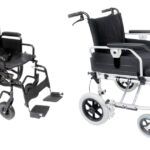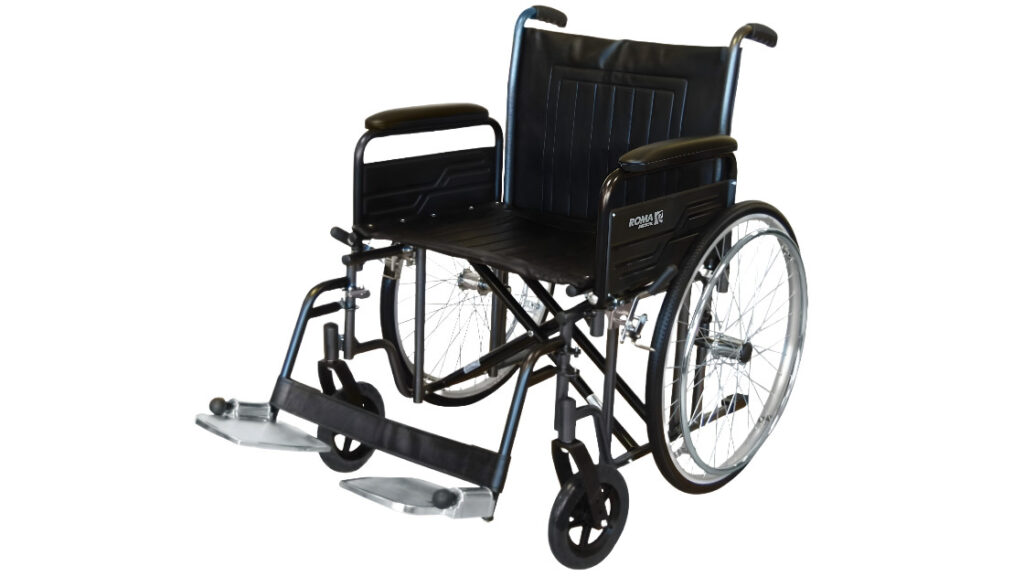
In today's fast-paced world, mobility shouldn't be a limitation. For individuals with limited mobility due to size or other conditions, finding the right wheelchair can be life-changing. That's where heavy-duty bariatric wheelchairs come in!
This comprehensive guide explores everything you need to know about these specialized wheelchairs. We'll delve into features, benefits, and crucial considerations to help you make an informed decision. Remember, consulting a healthcare professional is vital to ensure the chosen wheelchair perfectly meets your individual needs for optimal comfort and support.
Table of Contents
Why Choose a Heavy-Duty Bariatric Wheelchair?
Heavy-duty bariatric wheelchairs are specifically designed for people who require extra support and stability. They boast robust frames, wider seats, and can handle higher weight capacities than standard wheelchairs. This translates to:
- Enhanced Independence: Navigate your environment with greater ease, promoting self-reliance and a sense of freedom.
- Improved Quality of Life: Participate in daily activities and social outings more comfortably, enriching your life.
- Increased Safety and Stability: The sturdy build ensures a safe and secure ride, reducing the risk of falls or injuries.
Key Features to Consider When Choosing a Heavy-Duty Bariatric Wheelchair
- Weight Capacity: This is paramount! Choose a wheelchair that safely supports your weight for optimal safety and to prevent damage to the wheelchair itself.
- Seat Width: Wider seats provide superior comfort and proper positioning, minimizing pressure and fatigue during extended use. Consider your body dimensions to find the most comfortable option.
- Durability: Look for wheelchairs with strong frames, ideally made from steel or high-quality aluminum. This ensures the wheelchair can withstand everyday wear and tear for long-lasting use.
- Manoeuvrability: Easy turning and navigating tight spaces are essential for everyday life. Features like swivel front wheels and responsive brakes significantly improve manoeuvrability..
- Comfort: Padding, adjustable backrests, and armrests make a big difference for extended use. Consider features like breathable materials, pressure-reducing cushions, and adjustable leg rests to maximize comfort.
Top 5 Heavy-Duty Bariatric Wheelchairs
Finding the perfect wheelchair is crucial for maintaining comfort and independence. Here's a detailed breakdown of the top picks we highlighted from Mobility Shop, focusing on features that enhance comfort:
1. UGO Atlas Heavy Duty Steel Self-Propelled Wheelchair:
This option prioritizes support and adjustability for optimal comfort:
- Strong Steel Frame: Provides a sturdy base for a secure and stable ride.
- Four Seat Width Options (20", 22", 24", 26"): Ensure a perfect fit, minimizing pressure points and promoting proper posture.
- Padded Nylon Upholstery: Offers a comfortable seating surface that breathes well.
- Removable Armrests: Allow for easier transfers and side access for caregivers.
- Adjustable Footrests: These can be positioned for optimal leg support and comfort, reducing fatigue during extended use.
- Solid Puncture-Proof tyres: Provide a smooth ride and minimize the risk of flats, reducing maintenance worries.
Why Choose UGO Atlas?
Ideal for those who value independence and prioritize a balance between comfort and adjustability. The removable armrests and adjustable features make it a versatile option for various needs.
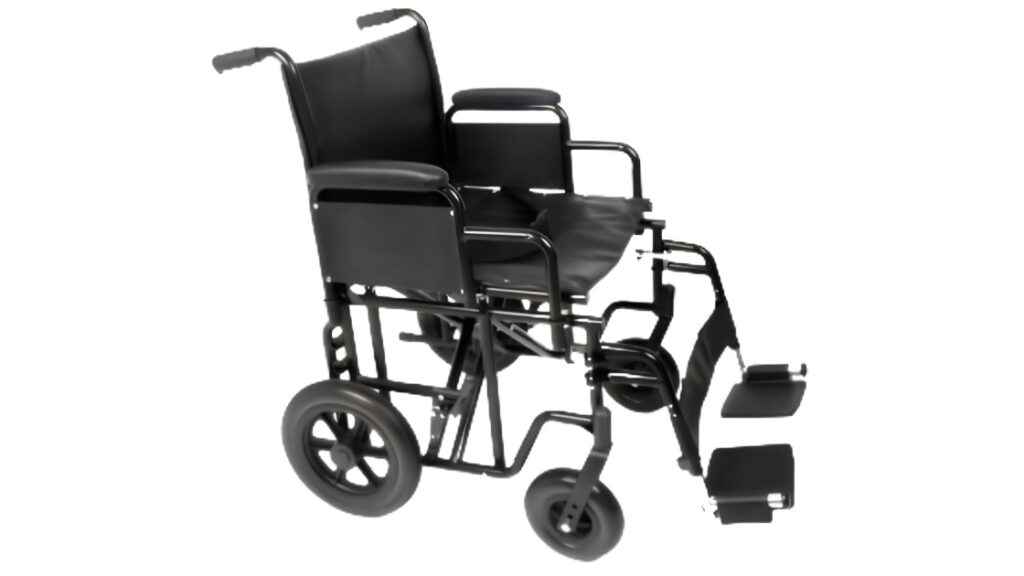
2. Esteem Heavy Duty Bariatric Transit Wheelchair:
This attendant-propelled wheelchair focuses on stability and ease of use for a comfortable ride:
- Heavy-Duty Steel Frame: Ensures a sturdy base for a safe and secure experience.
- Wide, Padded Seat: Offers ample space and comfort for extended use.
- Attendant Brakes: Allow the caregiver to control the wheelchair's speed and stopping power, promoting safety and comfort.
- Swing-Away Leg Rests: Can be easily removed or positioned for optimal leg support, enhancing comfort during transfers or resting.
- Solid Puncture-Proof tyres: Provide a smooth ride and minimize maintenance concerns.
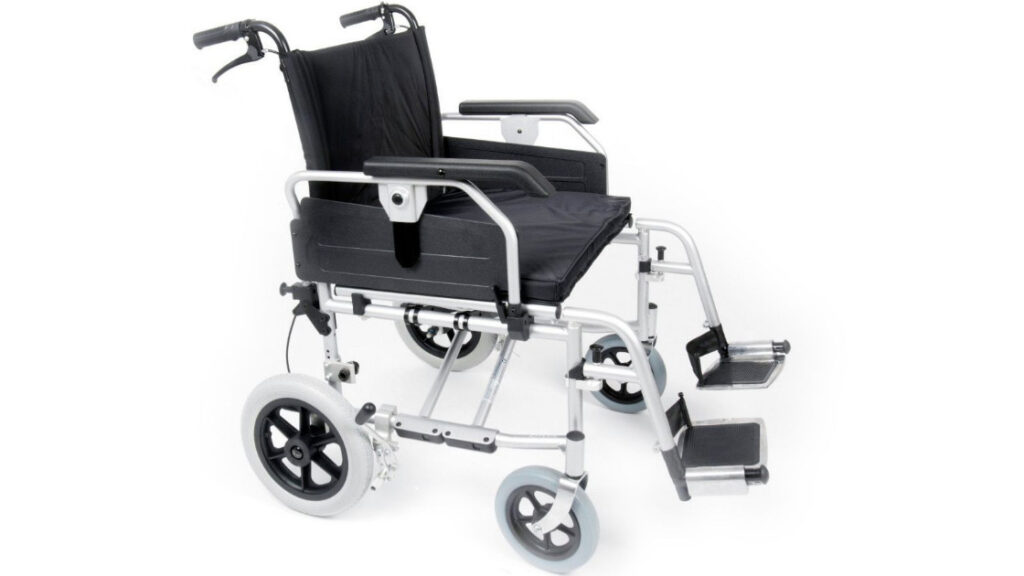
Why Choose Esteem?
A great choice for those who require assistance with movement. The attendant brakes and swing-away leg rests make it easy for caregivers to manoeuvre and ensure user comfort.
3. Drive Sentra HD Bariatric Transit Wheelchair:
This option offers a good balance between affordability and features:
- Heavy-Duty Steel Frame: Provides a sturdy base for a secure and stable ride.
- Wide, Padded Seat: Offers ample space and comfort for extended use.
- Attendant Brakes: Allow the caregiver to control the wheelchair's speed and stopping power, promoting safety and comfort.
- Elevating Leg Rests: These can be adjusted to different heights for optimal leg support and improved circulation.
- Solid Puncture-Proof tyres: Provide a smooth ride and minimize maintenance concerns.
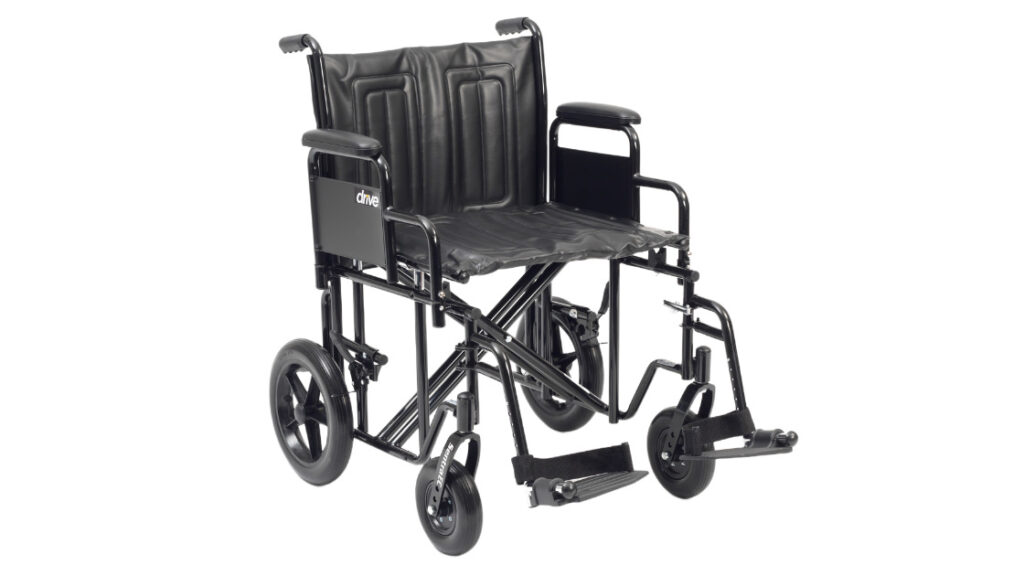
Why Choose Drive Sentra HD?
This is a budget-friendly option with features that enhance comfort and functionality for both users and caregivers. The elevating leg rests are a great feature for improving circulation during long periods of sitting.
4. Drive Bariatric Sentra EC Self-Propelled Wheelchair:
Designed for independence and comfort:
- Heavy-Duty Steel Frame: Provides a sturdy base for a secure and stable ride.
- Wide, Padded Seat: Offers ample space and comfort for extended use.
- Dual Armrests with Pressure-Relief Padding: Provide extra comfort and support for the arms.
- Adjustable Backrest: This can be reclined for added comfort during long journeys or resting.
- Solid Puncture-Proof Tyres: PTyresrovide a smooth ride and minimizes maintenance concerns.
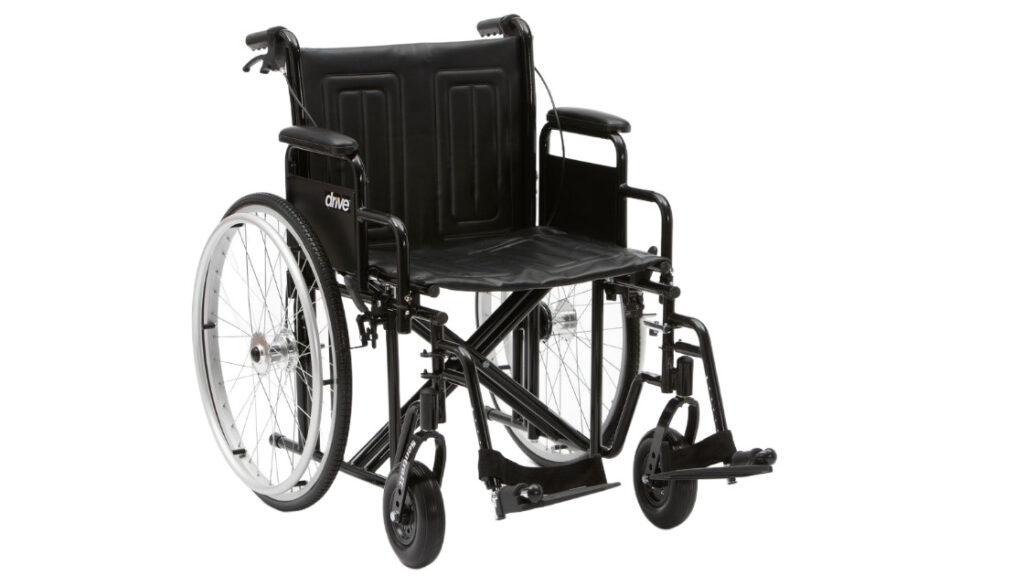
Why Choose Drive Bariatric Sentra EC?
This self-propelled option prioritizes comfort for independent users. The pressure-relief padding on the armrests and adjustable backrests make it a great choice for extended use.
5. Roma 1485 Heavy Duty Transit Wheelchair (and Roma 1485X-HD):
These attendant-propelled options focus on stability and user experience:
- Heavy-Duty Steel Frame: Provides a sturdy base for a secure and stable ride. (The Roma 1485X-HD boasts an extra-wide frame for additional support)
- Wide, Padded Seat: Offers ample space and comfort for extended use.
- Attendant Brakes: Allow the caregiver to control the wheelchair's speed and stopping power, promoting safety and comfort.
- Swing-Away Leg Rests: Can be easily removed or positioned for optimal leg support, enhancing comfort during transfers or resting.
- Solid Puncture-Proof Tyres: Provide a smooth ride and minimize maintenance concerns.
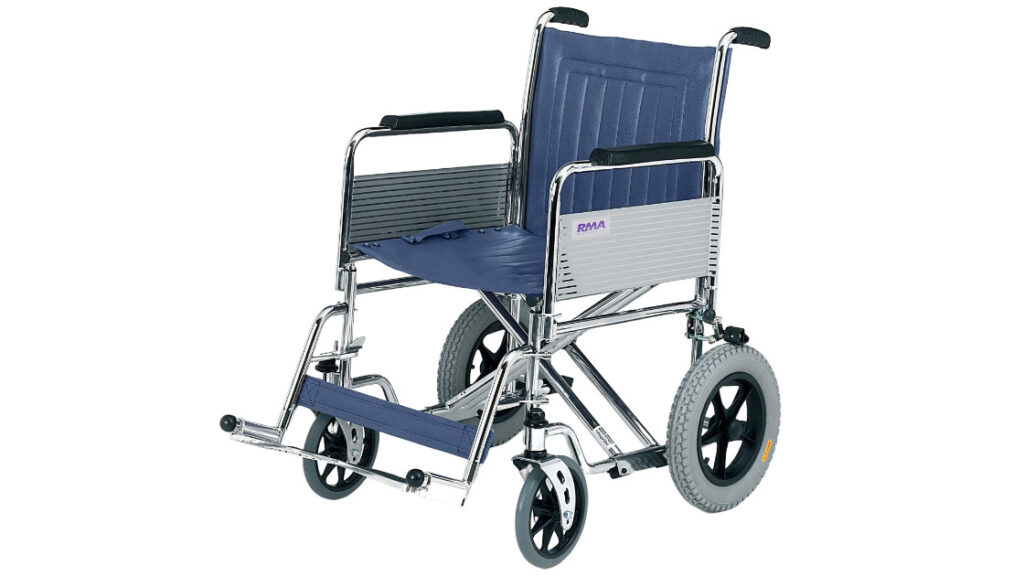
Why Choose Roma 1485 or Roma 1485X-HD?
These are great options for those who require assistance with movement. The Roma 1485X-HD offers an extra-wide frame
Final Thoughts:
- Comfort is Key: Don't compromise on comfort. Choose a wheelchair that provides proper support, pressure relief, and adjustability to suit your needs.
- Consider Your Lifestyle: Think about how you'll be using the wheelchair – daily activities, outings, and purpose (self-propelled vs. attendant-propelled).
- Explore All Options: Research and compare different wheelchairs to find the best fit for your budget and preferences.
- Invest in Yourself: A quality wheelchair is an investment in your well-being and independence.
We hope this comprehensive guide has empowered you on your journey towards finding the perfect bariatric wheelchair. With the right choice, you can unlock a world of possibilities and rediscover the freedom of mobility and exploration. Happy Rolling!
Frequently Asked Questions
What is a bariatric wheelchair?
A bariatric wheelchair is a specialized wheelchair designed for users who require extra support and stability due to their size. They are often referred to as "heavy-duty" wheelchairs because they boast reinforced frames, wider seats, and can handle significantly higher weight capacities than standard wheelchairs.
What does "bariatric" mean in terms of wheelchairs?
In the wheelchair world, "bariatric" refers to a category of wheelchairs specifically designed to accommodate larger individuals. These wheelchairs are built stronger and wider to ensure safety, comfort, and optimal performance for users with a higher weight range.
How much does a bariatric wheelchair weigh?
Bariatric wheelchairs typically weigh more than standard wheelchairs due to their heavier frames and reinforced components. The exact weight can vary depending on the model, size, and features. However, they generally range from 113kg to 158 kg, with some heavy-duty models reaching up to 225kg.
Who needs a bariatric wheelchair?
Bariatric wheelchairs are ideal for individuals who require a wheelchair due to limited mobility and whose weight exceeds the capacity of a standard wheelchair. They are also beneficial for those who need extra support and stability due to size or other conditions. Consulting a healthcare professional can help you determine if a bariatric wheelchair is the right choice for you.
What is the difference between a wheelchair and a bariatric wheelchair?
Standard wheelchairs are designed for everyday use and typically have a weight capacity of around 100-120kgs and a seat width of 16-18 inches. Bariatric wheelchairs, on the other hand, are specifically built for users who require extra support and stability due to their size. They boast:
Reinforced frames: Made from stronger materials like steel to handle higher weight capacities (usually 115kg or more).
Wider seats: Ranging from 18 inches to 26 inches or even wider, providing increased comfort and pressure relief for larger users.
More durable components: Enhanced brakes, wheels, and overall construction to ensure a safe and secure ride.
How do you fold a bariatric wheelchair?
Folding mechanisms can vary depending on the specific bariatric wheelchair model. However, most follow a similar principle to standard wheelchairs. Look for levers or release buttons on the frame that allow you to fold the backrest and footrests inwards, then fold the wheelchair frame itself for compact storage or transportation.
At Mobility Shop, we provide detailed product descriptions that often include folding instructions or videos. If you're unsure, consult the user manual or contact the manufacturer for specific folding instructions.
How wide is an obese wheelchair?
The term "obese wheelchair" isn't a standard term, but it likely refers to a bariatric wheelchair. Bariatric wheelchairs offer a wider range of seat widths compared to standard options. These typically start at 20 inches and can go up to 30 inches or even wider to accommodate users with a larger body size.
What is a heavy-duty wheelchair?
A heavy-duty wheelchair is another term often used interchangeably with a bariatric wheelchair. They share similar characteristics, including:
Stronger frames: Made from steel or high-quality aluminium for increased weight capacity.
Durable components: Designed to withstand everyday use and heavier users.
Wider seats: Providing additional comfort and support.
How large is a bariatric wheelchair?
Bariatric wheelchairs can vary in size depending on the model and features. However, they are generally larger than standard wheelchairs due to their:
Wider seats: As mentioned earlier, ranging from 20 inches to 30 inches.
Reinforced frames: Made from thicker tubing for added support.
Larger wheels: Sometimes used to improve stability and handling.
How wide is an adult wheelchair?
Standard adult wheelchairs typically have a seat width of 16-18 inches. However, bariatric wheelchairs, designed for adults who require a wider seat for comfort and support, offer a wider range of options starting from 20 inches and going up.
What is the difference between 18 and 20-inch wheelchairs?
The main difference between an 18-inch and a 20-inch wheelchair seat width is the amount of space it provides for the user. A 20-inch seat offers 2 inches more width, which can significantly impact comfort and pressure relief, especially for larger users.
Choosing the right seat width is crucial. It should be wide enough to comfortably accommodate your hips and thighs without causing pressure points. Mobility Shop offers a variety of bariatric wheelchair options to ensure you find the perfect fit for your needs.
Who makes the best bariatric wheelchair?
There isn't a single "best" brand for bariatric wheelchairs, as individual needs and preferences vary. However, some reputable manufacturers are known for their quality and selection of bariatric wheelchairs. Here at Mobility Shop, we carry a wide range of bariatric wheelchairs from trusted brands, including:
1. U-Go
2. Days Healthcare
3. Drive DeVilbiss (Drive Medical)
4. Roma Medical
We recommend considering factors like weight capacity, seat width, features, budget, and user reviews when making your choice.
What is the difference between a lightweight and a heavy-duty wheelchair?
The key difference lies in the materials, weight capacity, and intended use:
Lightweight wheelchairs: These are typically made from aluminium or lightweight alloys, making them easier to manoeuvre and transport. However, they have a lower weight capacity (around 113 kg to 136 kg) and may not be suitable for larger users.
Heavy-duty wheelchairs (bariatric wheelchairs): Made from stronger materials like steel to support higher weight capacities (usually 159 kg or more). They often have wider seats and more robust components for increased stability and durability.
How large is a bariatric wheelchair?
Bariatric wheelchairs are designed to accommodate users who require extra support and space compared to standard models. They are generally larger due to:
Wider seats: Bariatric wheelchairs offer a wider range of seat widths, typically starting from 20 inches and going up to 30 inches or even wider, for increased comfort and pressure relief.
Reinforced frames: Made from stronger materials like steel to support higher weight capacities (usually 159 kg or more).
Larger wheels: Sometimes used to improve stability and handling.
How do you push a heavy person in a wheelchair?
Pushing a heavy person in a wheelchair requires proper technique and may benefit from additional assistance depending on the situation. Here are some tips:
Maintain good posture: Stand with your feet shoulder-width apart, core engaged, and back straight.
Use your legs: Push with your legs, not your back, to propel the wheelchair forward.
Engage the brakes: Apply the brakes before coming to a complete stop to prevent the wheelchair from rolling.
Use momentum: When possible, use inclines or gentle slopes to gain momentum for easier manoeuvring.
How much does a bariatric wheelchair weigh?
Due to their reinforced frames and larger size, bariatric wheelchairs typically weigh more than standard wheelchairs. The weight can vary depending on the model and materials used, but the range is generally between 15 kg to 20 kg or more for heavy-duty models.
What is the difference between a bariatric wheelchair and a heavy-duty wheelchair?
"bariatric wheelchair" and "heavy-duty wheelchair" are often used interchangeably. They share key characteristics, including:
Stronger frames: Made from steel or high-quality aluminium for increased weight capacity.
Durable components: Designed to withstand everyday use and heavier users.
Wider seats: Providing additional comfort and support.
What is the difference between a standard and heavy-duty wheelchair?
The main difference lies in the weight capacity and features designed to support heavier users:
Standard wheelchair: Typically has a weight capacity of 113 kg to 136 kg, a seat width of 16-18 inches, and may be made from lightweight aluminium for easier manoeuvrability.
Heavy-duty wheelchair (bariatric wheelchair): Designed for users exceeding the capacity of standard models. They offer a higher weight capacity (usually 159 kg or more), wider seat options (starting from 20 inches), and sturdier frames for increased stability.
What is a HD wheelchair?
HD wheelchair stands for "Heavy-Duty Wheelchair." These wheelchairs are designed for users who require extra support and stability due to their size or weight. They share characteristics with bariatric wheelchairs.
How wide is a heavy-duty wheelchair?
Heavy-duty wheelchairs, often referred to as bariatric wheelchairs, offer a wider range of options. These typically start at 20 inches and can go up to 30 inches or even wider to accommodate users with a larger body size.
Which is better, an aluminium or steel wheelchair?
The choice between aluminium and steel for a wheelchair frame depends on your needs and priorities:
Aluminium: Generally lighter, making them easier to manoeuvre and transport. However, they may have a lower weight capacity (around 113 kg to 136 kg) and might not be suitable for heavier users.
Steel: Stronger and more durable, offering a higher weight capacity (typically 159 kg or more) for bariatric wheelchairs. The trade-off is that steel wheelchairs tend to be heavier overall.
What is an obese wheelchair called?
The medical term for treating obesity is "bariatric." So, a wheelchair specifically designed for users with a larger body mass index (BMI) is called a bariatric wheelchair. It's not a common term to hear "obese wheelchair," but it likely refers to the same concept.
Are wheelchairs with bigger wheels easier to push?
Larger wheels can offer some advantages when pushing a wheelchair:
Easier to overcome obstacles: Larger wheels can roll over bumps and uneven surfaces more easily, requiring less effort from the person pushing.
Improved stability: Larger wheels can contribute to a smoother ride and better overall stability, especially on outdoor terrain.
However, bigger wheels also add weight to the wheelchair. Here at Mobility Shop, our selection of bariatric wheelchairs includes models with various wheel sizes to suit different needs and preferences.
How do you transport a heavy wheelchair?
Transporting a heavy bariatric wheelchair requires planning. Standard vehicle trunks might work if it folds and is secured. Consider wheelchair accessible vehicles (WAVs) with ramps and securement systems. Hitch-mounted, roof-mounted carriers, or mobility trailers are other options. Public transport with lifts and designated wheelchair areas is also a possibility. Consult a healthcare professional or mobility specialist for the most suitable transportation method for you.

